What is Submerged Washing?
Our company has been selling its uniquely developed Submerged Washing method called "U-Jet" since 1985. This section describes the cleaning effect of Submerged Washing.
Submerged Spraying and Cavitation
When a water jet is sprayed under water, it meets resistance from surrounding water, and this greatly reduces the power of the jet.
Figure 1 shows the relationship between the distance from the nozzle outlet and jet spraying pressure when spraying both under water and in the open air. In open air spraying, there is no attenuation of the jet stream for a distance of approximately up to 100 mm from the nozzle outlet. In submerged spraying, there is attenuation starting at a distance of about 20 mm, and at about 90 mm, the strength of the jet is reduced to half.
Therefore, when spraying the jet under water, the power of the spray is greatly reduced by the resistance of the water. However, cavitation is created between the jet and its surrounding water. The ultrasonic cleaning widely used in the washing of semiconductors and precision machine parts makes use of cavitation. 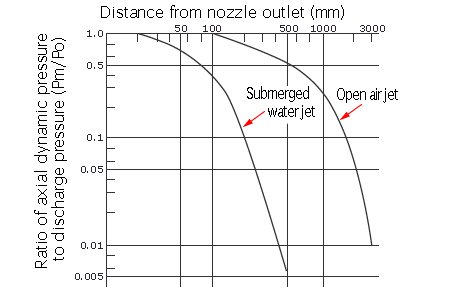
Figure 1. Comparison of jet force
Cavitation is a phenomenon in which the pressure in a liquid drops below the saturation vapor pressure and begins to boil, resulting in the creation of micro-bubbles.
In submerged spraying, a vortex occurs between the jet and the surrounding water, and cavitation is created when the eye of the vortex experiences a drop in pressure in a similar manner to that of a typhoon. The micro-bubbles created by cavitation flow downwards and burst instantly when the surrounding pressure rises.
When this happens, an impact pressure of up to several GPa produces an intense noise, and this causes damage to the surface of the object located in the downstream of the jet. Submerged Washing creates synergy between the washing power of cavitation and the spraying power of the jet.
Horn-type Nozzle: Submerged Spraying Brain Nozzle
Cavitation occurs by spraying the jet under water. The "Horn-type Nozzle" developed by Sugino Machine creates effective cavitation regardless of the simplicity of shape.
The nozzle has a tapered shape with its outlet spreading outward, and water sucked into the tapered part facilitates the creation of a vortex in the surrounding of the jet, resulting in the effective production of cavitation. (Figure 2)
In addition, it is being reported that the single individual bubbles of the cavitation bubble cloud, for which a concentration of micro-bubbles occurs in the downstream of the jet, provide a great deal of destructive power.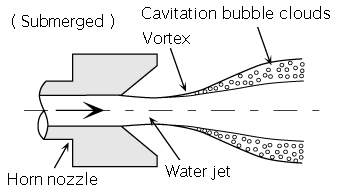
Figure 2. Horn-type Nozzle
Figure 3 shows the brick erosion amount in the case of submerged spaying with a Horn-type Nozzle and conventional type nozzle, which has a flat nozzle outlet. The conditions include a nozzle diameter of 1 mm, pressure of 30 MPa, and spraying time of 10 seconds.
The Horn-type Nozzle has an erosion amount that is approximately 10 times greater than the conventional nozzle, and it has been presumed that cavitation has been effectively generated. Furthermore, a maximum amount of erosion is obtained when the distance between the nozzle samples is 40 to 50 times the nozzle diameter. All of Sugino Machine's Submerged Washing machines use the Horn-type Nozzle.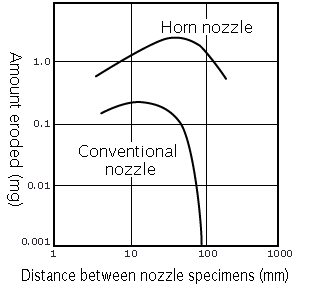
Figure 3. Comparison of erosion amount
Photo 1 shows the submerged spraying effect using the Horn-type Nozzle.
The jet was sprayed at a brick both under water and in open air. The submerged jet stream passed through the brick, leaving a hole diameter that was about 2 times the size of that of the open air jet spray. This test shows that submerged spraying has an authoritative superiority over open air spraying. Test conditions include a nozzle diameter of 1.5 mm, pressure of 30 MPa, and spraying time of 10 seconds, and distance between nozzle samples of 30 mm.
Submerged spraying that uses this type of cavitation demonstrates a superior washing power over open air spraying by using the Horn-type Nozzle.
Photo 1 Brick erosion test
Submerged spraying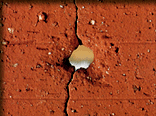
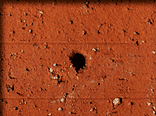
▲A penetration hole was created as well as cracking, Open air spraying ![]()
